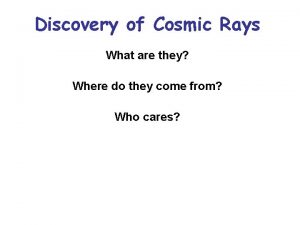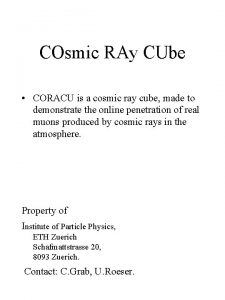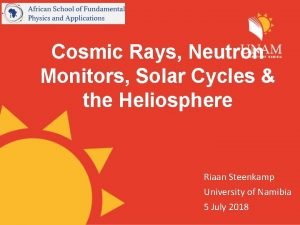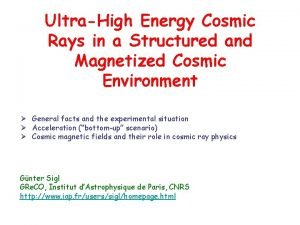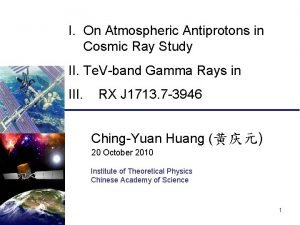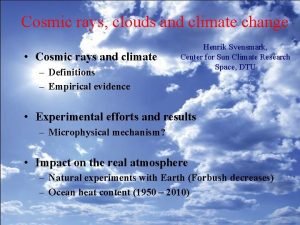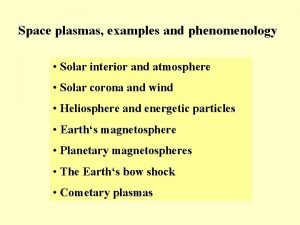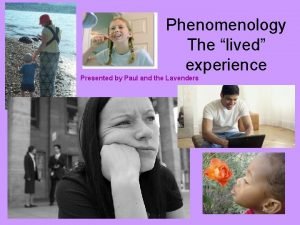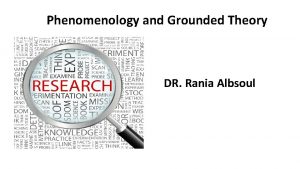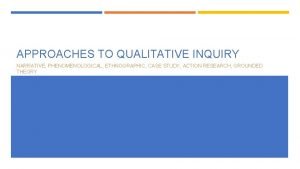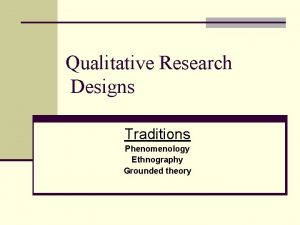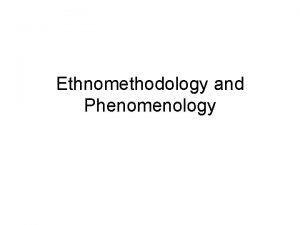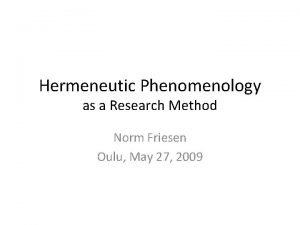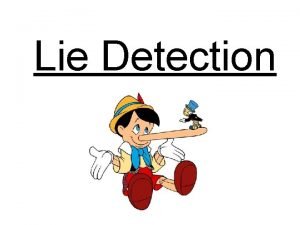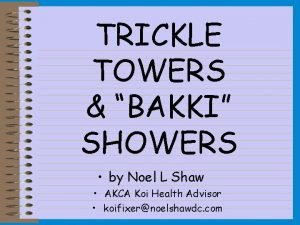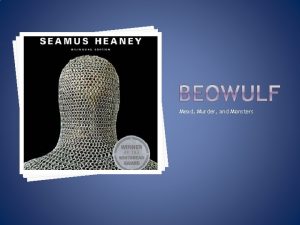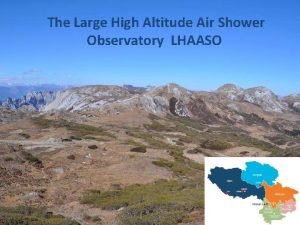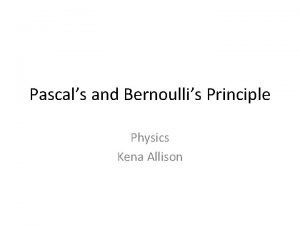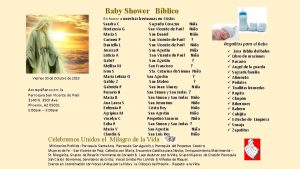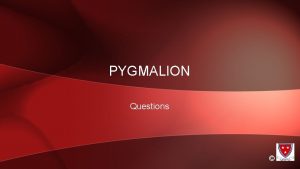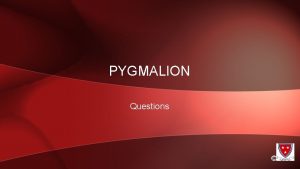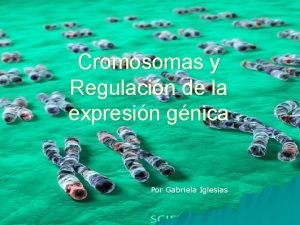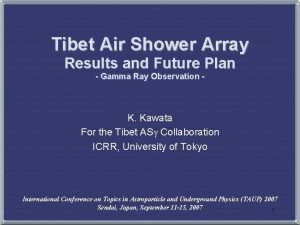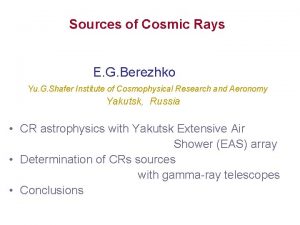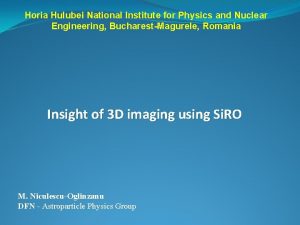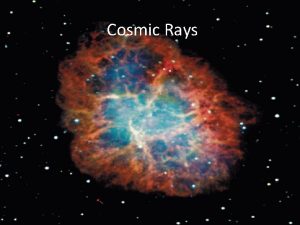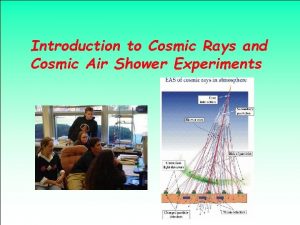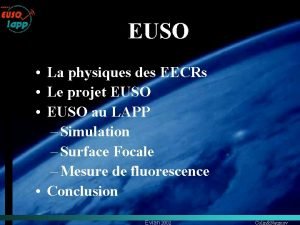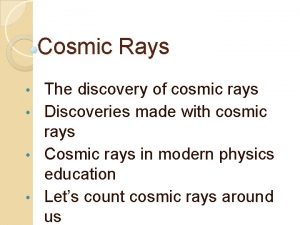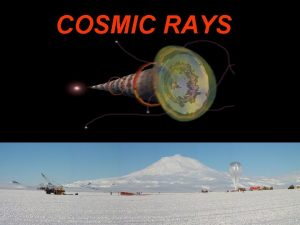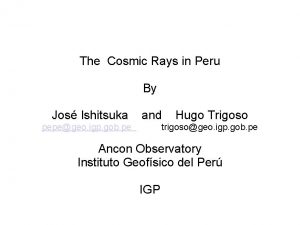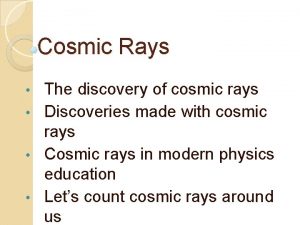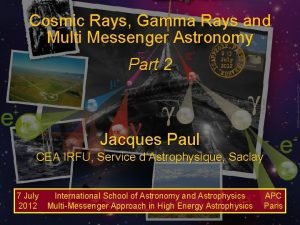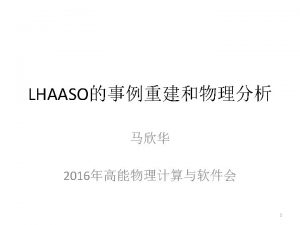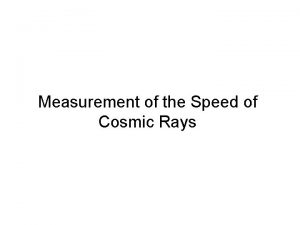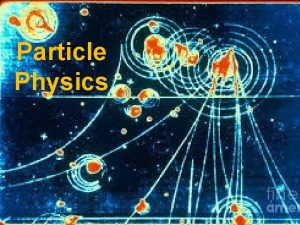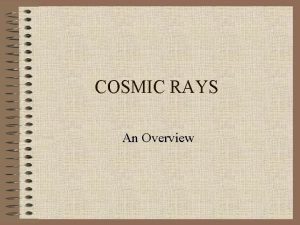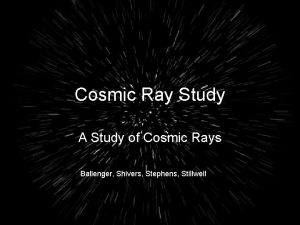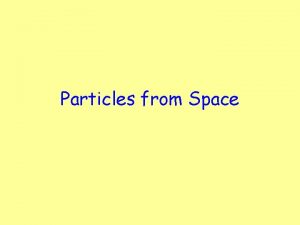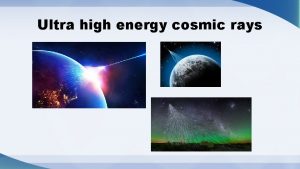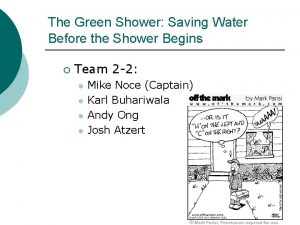EUSO Shower Phenomenology Cosmic Rays detection history From







































- Slides: 39

EUSO Shower Phenomenology Cosmic Rays detection history: From golden leaf electroscope to detection from space EUSO detection of showers: End 2 End simulation: First interaction Shower development Fluorescence and Cherenkov signal Atmosphere response Detector response Key uncertaintes and Atmosphere Sounding: Benefits from ASD domain of applicability Autonomous Method

Cosmic Rays detection history: What are cosmic rays? A short history What are Extensive Air Showers? EUSO energy spectrum domain

Courtesy by V. Naumov

Even very well isolated gold-leaf electroscopes are discharged at a slow rate. … observed by scientists before 1900 J. Elster, H. F. Geitel, C. Wilson investigated this phenomenon and concluded that some unknown source of ionizing radiation existed. Wilson even surmised that the ionization might be “…due to radiation from sources outside our atmosphere, possibly radiation like Röntgen rays or like cathode rays, but of enormously greater penetrating power. ” A gold-leaf Bennet-type electroscope (ca. 1880 s) manufactured by Ducretet. 1900 -1901 Soon after, two Canadian groups, Ernst Rutherford and H. Lester Cooke (1903) at Mc. Gill University, and J. C. Mc. Lennan and E. F. Burton (1902) at the University of Toronto showed that 5 cm of lead reduced this mysterious radiation by 30%. An additional 5 t of pig lead failed to reduce the radiation further. Courtesy by V. Naumov

Courtesy by V. Naumov

Victor Hess won The Nobel Prize in Physics 1936 "for his discovery of cosmic radiation". Background of the slide: H. E. S. S. (High Energy Stereoscopic System) a next-generation system of Imaging Atmospheric Cherenkov Telescopes for the investigation of cosmic gamma rays in the 100 Ge. V energy range. Courtesy by V. Naumov

Courtesy by V. Naumov

Up to now EAS are detected on the Earth ground Today the largest ground detector Pierre Auger in Argentina camps will cover ~3000 km 2 surface and detect both: ✗Charged particles ✗Fluorescent light

Hires is a fluorescent detector AGASA is a charge track detector A lower energy data suggests a dominance of the protons… • The AGASA data seems to conflict to both Hires and GZK prediction. • There is also a 2 times difference in the flux measurement between Hires and AGASA at low energies!

Courtesy by C. Lauchaud

Fresnel mirror 10 rings

Goal: TUS 2: KLYPVE:

(1) Double TUS is approved by Ros. Avia. Kosmos to fly as a free flyer in 2007. (2) Its mission is basically to test the approach, measure the background and collect a dozen of events per year! (3) We are looking to for a ground based tests/calibration of the detector now.

mold production in JINR/Dubna Space qualified carbon-plastic Fresnel mirror to be produced @ “Luch” (Syzran)

Orbiting Wide Angle Light-collector (OWL) Original concept Air. Watch (1996) Improved every year Two satellites flying in formation Angular Resolution: 0. 2 Energy Resolution: 14% Aperture: 2 X 106 km 2 ster Duty Cycle ~12% Eff. Aperture: 2. 3 X 105 km 2 http: //owl. gsfc. nasa. gov ster

EUSO: ISS stationed optics 2 m diameter Fresnel lenses 30 o Fo. V 3 years data taking Now end of Phase A

EUSO detection of showers: End 2 End simulation: First Interaction Point Direct simulation for hadrons according to hadron-air crosssection (anti) neutrinos first depth is about 1. e 7 g/cm 2 thus the neutrino first interaction point is proportional to the air density

EUSO detection of showers: End 2 End simulation: Shower development CORSIKA QGSJET parametrization called GIL (Greizen-Ilyina-Linsley) Proton 1. e 20 e. V Hybrid MC (UNISIM) Iron 1. e 20 e. V

EUSO detection of showers: End 2 End simulation: Shower development CORSIKA QGSJET parametrization called GIL (Greizen-Ilyina-Linsley) Proton 1. e 20 e. V Hybrid MC (UNISIM) Iron Energy distribution of charged particles is of importance for both fluorescence anc cherenkov (Varius parametrizations of CORSIKA and like packages) 1. e 20 e. V

EUSO detection of showers: End 2 End simulation: Fluorescence and Cherenkov signals Is a very exciting topic today: Nitrogen excitations studied in past: Guner, 1964/Buner, 1967 Davidson & O’Neil, 1964 Kakimoto et al 1996 Nagano et al, 2000 ONLY (Palermo, Paris) Paris low energy spectrometr AIRFLY (Rome) FLASH(SLAC) SLAC MACFLY(CERN) Medium energy (Campaninas) Karlsrhue Cofin (Italy)

EUSO detection of showers: End 2 End simulation: Fluorescence and Cherenkov signals Fluorescence energy dependence is reflected into shower age dependence

EUSO detection of showers: End 2 End simulation: Fluorescence and Cherenkov signals refractive index as a function of the atmosphere state (T, P, water content, etc) energy distribution of electrons in shower Back-Scattered in EUSO direction Both fluoresent and cherenkov signals are delayed due to refractive index… few nsec

EUSO detection of showers: End 2 End simulation: Fluorescence and Cherenkov signals refractive index as a function of the atmosphere state (T, P, water content, etc) energy distribution of electrons in shower Back-Scattered in EUSO direction Both fluoresent and cherenkov signals are delayed due to refractive index… few nsec

EUSO detection of showers: End 2 End simulation: Atmosphere response Light absorbtion/reflection Rayleigh scattering Mie scattering Ozone layer absorbtion Lowtran 7. 1 code handles all these and many other effects for us

EUSO detection of showers: End 2 End simulation: Detector response Buffle/Detector Geometry Optics Transport Focusing Absorbtion/Reflection PMT simulation AFEE Triggering

EUSO Frequently Used Software UNISIM PARIS S. Bottai ESAF reads UNISIM generated files with photons on entrance pupil ESAF is able to read UNISIM generated files with a shower track E. Plagnol Common features: 3 D Geometry and Earth Curvature hadron-air initial interaction Production of fluorescent and cherenkov light Atmosphere response HYBRID METHODS : FULL MC SIMULATION FOR E>Eth , PARAMETRIZATION FOR E<Eth. Good reproduction of fluctuations with Eth=1017 e. V. LPM EFFECT INCLUDED NEUTRINO SIMULATION OF EHE NEUTRINO INTERACTIONS CC+NC Single cherenkov scattering Clouds simulation SLAST D. Naumov ESAF light production engine Energy distribution of electrons in shower (impact on both fluorescent and cherenkov light) Easy configurable atmosphere profiles, attenuation, detector parameters Neurino CC +NC interactions D. Naumov, EUSO-SDA-015

Key uncertaintes and ASD Key uncertaintes: Theory of showers @ UHE Fluorescence production Atmosphere Status Clouds, Earth relief Cherenkov albedo Detector aging

Key uncertaintes and ASD Key uncertaintes: Theory of showers @ UHE Fluorescence production Atmosphere Status Clouds, Earth relief Cherenkov albedo Detector aging (1) Models implemented in CORSIKA give Ne(x) with 20 -25% difference (2) Experimental measurements at accelerators are restricted to high Pt while UHECR interact mainly with small Pt

Key uncertaintes and ASD Key uncertaintes: Theory of showers @ UHE Fluorescence production Atmosphere Status Clouds, Earth relief Cherenkov albedo Detector aging (1) Precise measurements @ 50100 Me. V energy of electrons is desired (2) The experiments are VERY difficult. Need to measure the spectrum, yield in presence of varius contaminations, its dependence on T, P (3)Today 20 -30% are likely to be reduced to 7. 5% with forthcoming years

Key uncertaintes and ASD Key uncertaintes: Theory of showers @ UHE Fluorescence production Atmosphere Status Clouds, Earth relief Cherenkov albedo Detector aging (1) Need to know the air density, pressure, temperature, attenuation

Key uncertaintes and ASD Key uncertaintes: Theory of showers @ UHE Fluorescence production Atmosphere Status Clouds, Earth relief Cherenkov albedo Detector aging (1) Clouds effects are manifold: (2) reflect Cherenkov light (3) absorb and distort the fluorescence light (4) Increase the fluorescence background (5) Earth relief (mountains, hills, holes etc) even in absence of clouds can mimic a different reflection surface

Key uncertaintes and ASD Key uncertaintes: Theory of showers @ UHE Fluorescence production Atmosphere Status Clouds, Earth relief Cherenkov albedo Detector aging (1) Depends on the scattering surface: Earth or clouds (2) Is about 3 -7% over Earth (3) Enhanced up to 60% over clouds

Key uncertaintes and ASD Key uncertaintes: Theory of showers @ UHE Fluorescence production Atmosphere Status Clouds, Earth relief Cherenkov albedo Detector aging (1) Optics, PMT, filters are aging, loosing their performance (2) Need constantly to monitor the overall detector performace (3) A special monitor device is needed

Key uncertaintes and ASD What do we need to reconstruct energy and Xmax? Need to know Hmax: two ways Time difference between photons from the shower maximum and Cherenkov echo (need an external control for scattering surface) Atmosphere (+cloud) attenuation (H) Fluorescence yield (H)

Key uncertaintes and ASD Atmosphere Sounding Device Purpose and requirements: Measure atmosphere transparency profile Detect clouds: their altitude and position, optical depth 3 Options are available:

Key uncertaintes and ASD Atmosphere Sounding Device What we could gain with ASD: Recover that there is 30% of clear sky (no correction) Try to recover showers with no maximum detected (due to clouds) Apply corrections for showers impacting on the clouds ASD (LIDAR) difficulties: Precise pointing device: EUSO Triggers ASD and reports microcell triggered EUSO or ASD electronics solves X, Y ambiguity of microcell output (reads X, Y or 4 PMT) 100 shots in 1 second Search for a cone around the shower track, thus sensitive to homogenous wide coverage of clouds 70% of cloudy sky DOES NOT MEAN the same fraction of showers impacting clouds: Dense clouds are lowlying and affect only vertical showers

Shower autonomous method Use only fluorescence 5 km 20 km Time development of two horizonthal showers. Nmax/Ntot ~ (h)

Shower autonomous method Altitude of Shower Maximum Reconstruction

Next talk is devoted to EUSO Reconstruction
 Cosmic rays discoverer
Cosmic rays discoverer Coracu
Coracu Cosmic rays
Cosmic rays Cosmic rays
Cosmic rays Cosmic rays
Cosmic rays Svensmark
Svensmark Nenl
Nenl Qualitative research process steps
Qualitative research process steps Phenomenology vs case study
Phenomenology vs case study Phenomenology strengths and weaknesses
Phenomenology strengths and weaknesses Phenomenology vs grounded theory
Phenomenology vs grounded theory Phenomenology vs ethnography
Phenomenology vs ethnography Phenomenology and ethnography
Phenomenology and ethnography Ethnomethodology and phenomenology
Ethnomethodology and phenomenology The lived
The lived Philosophical assumption
Philosophical assumption Characteristics of a dystopian society
Characteristics of a dystopian society Phenomenology
Phenomenology Anecdote example
Anecdote example History of lie detection
History of lie detection Bakki shower filter design
Bakki shower filter design Iron shower kenning
Iron shower kenning Waterfall vs shower approach
Waterfall vs shower approach Bernoulli’s principle states that
Bernoulli’s principle states that Large high altitude air shower observatory
Large high altitude air shower observatory Seoulin medicare
Seoulin medicare What does pascal’s principle state?
What does pascal’s principle state? Baby shower catolico
Baby shower catolico After they arrived the prisoners are supposed to shower
After they arrived the prisoners are supposed to shower Pygmalion analysis
Pygmalion analysis What purpose does the rain shower serve in pygmalion
What purpose does the rain shower serve in pygmalion Makeshift shower
Makeshift shower Ride present simple
Ride present simple Porcino
Porcino Chemistry learning center uiuc
Chemistry learning center uiuc I got outside
I got outside Tibet air shower array
Tibet air shower array Air shower
Air shower Navy shower technique
Navy shower technique Air shower
Air shower
